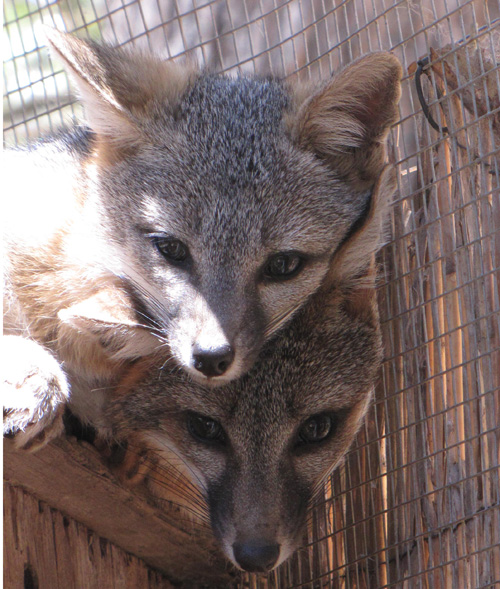
Since animals can’t speak our language, Sonoma County Wildlife Rescue is appealing to the community on their behalf.
Last year, the nonprofit organization responded to over 1,500 animal rescue calls, the majority of which involved human interaction with wildlife, according to Sonoma County Wildlife Rescue Executive Director Doris Duncan.
Yet Sonoma County Wildlife Rescue (SCWR) — established in 1981 by a small group of women concerned about the welfare of local wildlife — receives no government funding and relies solely on donations and fundraising.
“We have to raise $310,000 a year — or $849-plus per day — to keep our doors open, so we can do the work that we do,” Duncan said.
“If you find a little squirrel that fell out of a tree in your backyard and it is laying in the cold rain with no mother to take care of him, who are you going to call?” she said.
Though a more common scenario, currently, has to do with emaciated red tail and red-shouldered hawks, according to Duncan, who said SCWR has been seeing a lot of them lately.
“They are this year’s babies. We could compare them to our teenagers who go off to college and don’t do as well as they thought they would and they slowly start to starve and have to have somebody to take care of them until they get a little older and stronger,” she said.
More examples of what this rescue operation does can be found in the 2012 SCWR call logs. Entries this year resulting in volunteers and staff being dispatched to assist animals in need include the following:
“4/24/12: a mother fox was hit and killed by a car, (and found with) her two babies huddled next to her body on the side of a busy road. Our volunteer finds the babies, emaciated and dehydrated, and takes them to the SCWR hospital in Cotati.
“8/17/12: a red-shouldered hawk suffered a gunshot in its wing. It was found hopping around, near starvation. We were able to nurse it back after five months of care.
“10/25/12: a raccoon had its leg caught in an illegal steel jaws trap. The trap dug all the way into the bone and the raccoon had been dragging it around for days. The raccoon was so badly injured that all we could do was euthanize it, ending its suffering,” state the log entries which were printed in an appeal written to the general public, asking for financial assistance.
“No state or local government agency deals with the rescue and rehabilitation of wildlife. When a wild animal is injured or orphaned it either suffers a painful death or, if it’s lucky, will be euthanized by Animal Control,” the appeal states. “Our mission is to rescue and rehabilitate injured and orphaned wildlife and to end the suffering of those that can’t be rehabilitated. Ending the suffering of an injured animal is an important part of our job: if we aren’t there, an animal can suffer needlessly for hours, days — even weeks — before it loses its struggle to survive,” states the appeal, which Duncan echoed in a conversation with Sonoma West Publishers.
“I can’t tell you how scary it is right now for us,” she said, noting, the animals need SCWR and SCWR needs financial support in order to continue helping injured and orphaned animals.
Wildlife Rescue is also in the process of building a raptor recovery compound. The foundation is already built, but about $16,000 is still needed (which is in addition to general operating funds) to pay for the lumber to build the walls and the roof, Duncan said.
Since its inception over 30 years ago, the SCWR center has grown from a handful of enclosures at a private residence to a wildlife center with over 30 rehabilitation enclosures, eight wildlife exhibit enclosures and a wildlife hospital equipped for basic triage with a lab and pharmacy, according to information on the SCWR website.
However, tending to the orphaned and injured is not all Wildlife Rescue does. Sometimes an eviction is needed.
Apparently, it’s not uncommon for SCWR to get calls reporting skunks, possums, or raccoons under someone’s house or in their attic, according to Duncan, who said the animals are looking for places to nest.
“We have a wildlife exclusion service, which is how we do some of our fundraising,” she said, noting SCWR charges a lower rate than average and is a “life orientated wildlife service” that does not trap or kill any of the animals.
“We do evictions,” she said.
SCWR provides this service Tuesday through Saturday. To make an appointment, call 992-0276.
Wildlife tours are another source of fundraising for SCWR. For a small donation ($5 for adults, $3 for children) the general public can partake in a wildlife guided tour and see wolves, mountain lions, coyotes, foxes, skunks, raccoons, etc. To register for a tour call 992-0274.
Regarding wildlife people might come across on their own time that appear sick, injured or orphaned, Duncan recommends calling Sonoma County Wildlife Rescue to get advice on the situation before approaching the creature, “because every situation is different.”
The SCWR hotline — 526-WILD (9453) — takes calls from 9 a.m. to 10 p.m., seven days a week.
To Donate call Duncan at 992-0274, or mail a check to P.O. Box 448, Cotati, CA 94931.
For more information about Sonoma County Wildlife Rescue, go to www.scwildliferescue.org.
Every dollar makes a difference
Sonoma County Wildlife Rescue is a nonprofit organization that relies solely on public donations in order to rehabilitate 1,500 -plus sick, injured and abandoned animals each year.
With lots of hungry mouths to feed, even small donations make a difference. Following are a few examples of what it cost to feed some of the animals while at the wildlife center:
• $20 feeds three baby raccoons for one
week;
• $30 feeds five opossums for one week;
• $40 feeds one coyote for two weeks.
• $50 feeds four foxes for one week;
• $60 feeds one red-tailed hawk for one
month.
To donate, call Doris Duncan at 992-0274, or mail donations to Sonoma County Wildlife Rescue, P.O. Box 448, Cotati CA 94931.








